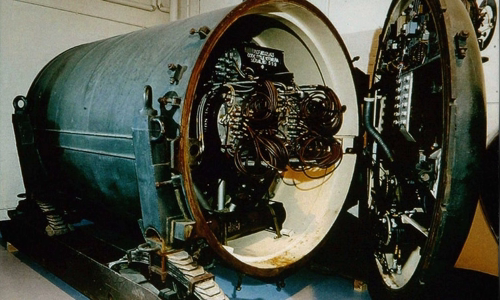He planned to bury a nuclear mine in Germany to block Soviet advance if a war broke out, but the project was canceled in 1958.
The Cold War was a very stressful time for European countries, when they were caught in the confrontation between the two superpowers America and the Soviet Union. The Soviet nuclear and military might worried Britain, prompting London to implement countermeasures in the event of an attack. One of them is the construction of nuclear mines in the project codenamed Blue Peacock.

The Blue Peacock mine prototype was kept after the Cold War Photo: War History
David Hawkings, a former employee of the British Atomic Weapon Agency, said the idea of making nuclear mines to block Soviet advance when the conflict broke out was proposed by the British War Office in late 1954. "Landmines The nuclear not only destroys infrastructure on a large scale but also prevents that area from falling into enemy hands due to radioactive contamination over the long term, "Hawkings said.
The nuclear mines of the Blue Peacock project can be activated remotely to inflict maximum damage to the enemy, while ensuring the safety of the British and allies.
However, a problem for designers is that this type of landmines cannot explode if the temperature is too low, below the operating threshold of the internal electronics. This poses a series of challenges, especially when mines are expected to be buried underground in the north of Germany, which has a relatively cold climate.
Still, the British army decided to build 10 nuclear mines, with the intention of transferring them to West Germany in October 1957 under the guise of a mobile nuclear generator for units stationed here.
Each mine weighs 7.2 tons, designed to be operated without supervision, in case the British army unexpectedly withdraws. It is integrated with anti-interference mechanisms, causing mines to explode in just 10 seconds if moved, chiseled or water penetrated.
Blue Peacock mines can be detonated with a 5 km control wire or a timer for up to 8 days. Each fruit can create a powerful explosion equivalent to 10,000 tons of TNT, leaving a deep pit with a diameter of 375 m and causing radiation pollution on a large scale.
After the method of insulating electronic devices inside the mine was unsuccessful, Britain tried a strange method of introducing chickens into a nuclear mine to warm up electronics.
By this method, British engineer engineer put a chicken in a nuclear mine with enough food and water for 8 days. The chicken's body temperature is sufficient to maintain the internal temperature, ensuring the mine can be activated when the countdown timer runs at its maximum.
However, the British Ministry of Defense decided to cancel the project in 1958 when only two prototypes were released because of fears that radiation from the explosion could spread to its territory. London is also concerned about political issues due to the secret of hiding nuclear weapons on allied territory. Documents related to the project were declassified and published in 2004.



 WendyGali
WendyGali







